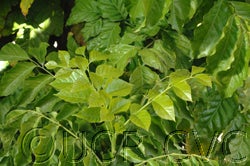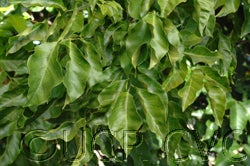Kai Sum wampee
CRC 3967
PI 296321
Source
Received as a cutting from Glenn Dale Quarantine Facility, origin not given, 1983.
Parentage/origins
Parents unknown.
Rootstocks of accession
own roots
Season of ripeness at Riverside
July to September
Season of flowering at Riverside
February to June
Description from The Citrus Industry Vol. 1 (1967)
"Oliver (1861, p. 34) gave a Latin diagnosis of this species that, translated, reads as follows: "Tree or shrub; branches at first pubescent or puberulous; leaves 5-7-9-foliolate, 20-25 cm long; leaflets ovate-elliptic, lanceolate or ovate, with petiolules 2-6 mm, more or less oblique at the base, apex obtuse or subemarginate, sometimes almost mucronulate, slightly acuminate, margin undulate-crenate or slightly serrulate, becoming glabrous or glabrescent, the midrib and veins often sparsely scabrous, glabrescent below; terminal leaflet often 6-10 cm long; flowers subsessile or shortly pedicellate, in many-flowered cymose panicles; calyx-5- (rarely 4-) merous, lobes triangular or ovate; stamens 10, alternate ones shorter, filaments dilated above the middle, flattened, subulate above, anthers oblong or elliptic, cordate-sagittate at base, with a dorsal gland; ovary shortly stipitate, glandular, very often 5-locular, ovules in pairs [in each locule], superposed, the upper one peltate on the side or toward the base, the lower one subpendulous; style very short, distinct, glabrous above, stigma 5-lobed, slightly wider than style; fruit usually with 5 locules, 5-seeded, or by abortion 1-seeded, or sterile, ovoid-globose, pubescent, 1 in. [25 mm] or less diam.; cotyledons fleshy, equal."
This species differs widely from all the other species of the genus, as has been noted. The wampee is a highly esteemed fruit tree in southern China, where sour, subacid, and sweet varieties are known. The white or yellow fruits are ovoid or subglobose, about the size of a pigeon’s egg, but varying in size and shape with the variety cultivated. The inflorescences are large panicles at the ends of the branches, so the fruits occur in rather openly-spaced clusters. In texture, the wampee fruit is much like a loquat and is a berry without a tough peel. An illustrated treatise in Chinese by Mill Tsen [Ts’êng Mien-chih, in Mandarin transliteration] (1936) described in detail six varieties and figured the fruit and a leaflet of each variety. (Mill Tsen mentioned another variety [no. 6 below], which is not figured.)
According to Mill Tsen, Professor Wên Wên-kuang of Sun Yat-sen University at Canton, China, listed eight varieties of the wampee grown in Kwangtung Province. These varieties are not described in detail but are given long descriptive names such as "white-hairy-chicken-heart-sweet-wampee"; "long-chicken-heart-sour-wampee"; "yellow-hairy-chicken-heart-sour-wampee," etc.
Although the wampee is only remotely related to Citrus, it can be grafted on a Citrus rootstock, and is thereby forced into early flowering and fruiting. The rough lemon can be grafted on the wampee and will grow for many years if a small branch of the wampee is allowed to grow just below the graft. Any desired Citrus fruit can be top-grafted on the rough lemon and may live for many years and may even be made to fruit. However, the graft union of the rough lemon on the wampee is poor and badly overgrown. Wampee on Citrus seems to make a much better and more permanent union."
Availability
Not commercially available through the Citrus Clonal Protection Program.
USDA Germplasm Resources Information Network page for Clausena lansium (CRC 3967)



